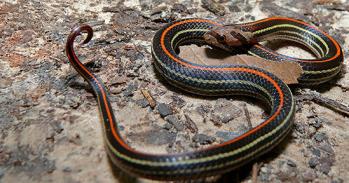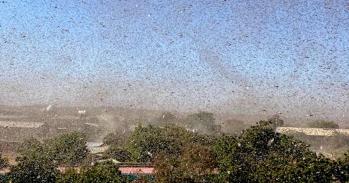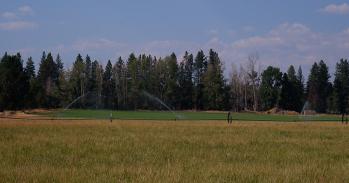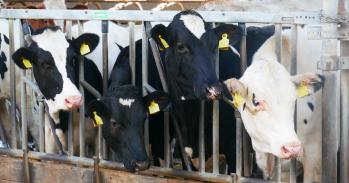
Plant scientists in Cambridge have embarked on ambitious plans to improve crop yields by solving one of the chief limitations of photosynthesis.
Plant scientists in Cambridge have embarked on ambitious plans to improve crop yields by solving one of the chief limitations of photosynthesis.
We’re looking ahead to at least 15–20 years from now, to transform crop production in the decades when the potential yield of current crops has been exhaustively maximised.
Dr Julian Hibberd
Wasteful, inefficient, ‘relic of a bygone age’ – all indictments that have been levelled at RuBisCO, the most abundant protein in nature and the heart of the reaction that feeds life on Earth. The enzyme is the powerhouse behind photosynthesis, responsible for taking CO2 from the atmosphere and using the sun’s energy to convert it into the sugars that crops need to grow.
But, as its full name, Ribulose 1,5-Bisphosphate Carboxylase/Oxygenase, might suggest, the enzyme has an unfortunate tendency to promiscuity. It evolved at a time when the Earth’s atmosphere was very different to the 500-fold excess of O2 over CO2 that we have today and, as a result, it sometimes mistakes O2 for CO2, to the detriment of potential plant productivity.
Plant scientists such as Dr Julian Hibberd and Professor Howard Griffiths believe that overcoming this inefficiency could be the key both to achieving a leap in the amount of food or energy a plant can produce from the same amount of sunlight and to revitalising the Green Revolution, which has been slowing as the yields of elite cultivars approach their natural limits.
Nature’s remedies
The approaches taken by the two scientists aim to maximise the operating efficiency of RuBisCO by turbocharging it with an increased concentration of CO2.
“Fortuitously, some plants have developed such a turbocharger,” explained Professor Griffiths. “Among them, certain land plants have an advanced type of photosynthesis termed C4, and aquatic algae have developed mechanisms that actively concentrate bicarbonate to provide a source of CO2 for the enzyme. Our research aims to emulate what nature has already accomplished, for the benefit of future food security.”
The main focus for Dr Hibberd is rice, a cereal grown in global regions where the population is predicted to grow fastest. “About 60% of the world’s population lives in Asia, where each hectare of land used for rice production currently provides food for 27 people, but by 2050 will have to support at least 43 people,” he said.
“One way to alleviate food shortages is to develop higher-yielding rice by reconfiguring its photosynthetic pathway towards that used by land plants that have evolved the upgraded version.”
Most of the world’s plants produce a sugar with a 3-carbon skeleton in a process termed C3 photosynthesis. In fact, bacteria developed this means to convert light energy into sugar about 3.4 billion years ago. Fast forward to a comparatively recent 30 million years ago, and the C4 pathway evolved, in which the initial CO2 fixation product is a 4-carbon organic acid. Today, C4 is found in 4% of plants including maize and sugarcane, as well as in 14 of the world’s 18 worst weeds.
“Remarkably, C4 photosynthesis has evolved independently in at least 62 lineages of plants,” added Dr Hibberd. “We think it developed in response to selection pressures such as low amounts of CO2, high temperatures and more arid conditions.”
Crucially, C4 plants produce higher yields for the same amount of light energy, have double the water-use efficiency of C3 plants, and their leaves use about 40% less nitrogen to achieve 50% higher yields. A host of biochemical, cellular and anatomical changes in the C4 plant result in a mechanism that first concentrates CO2 and then supplies it to RuBisCO in the C3 pathway.
And therein lies the challenge. To unpick the C4 apparatus and rebuild it in rice involves literally dozens of genetic changes, as well as alterations to biochemical reactions and even to the way the leaf is built. The project is requiring a major scientific effort, called the C4 Rice Consortium, funded by $22 million from the Bill & Melinda Gates Foundation.
Unpicking and rebuilding
The C4 Rice Consortium involves 12 partner institutions across four continents and is led by the International Rice Research Institute (IRRI) in the Philippines.
In the two years since the project began, the Consortium members have been working on a number of complementary approaches. Dr Hibberd’s team has been cloning genes required for the biochemical reactions, and transgenic strains of rice that express them are being grown at IRRI. Other groups are looking for C4 mutants that have lost their leaf anatomy, and C3 mutants that have developed it; and a vast gene sequencing screen is searching for new C4 genes.
Dr Hibberd’s recent findings, published in Science magazine in April 2011, suggest that genes present in C3 species can be recruited into cell-specific functions in the C4 pathway without alterations to their gene sequence. “The discovery dramatically alters the approaches being taken to engineer C4 photosynthesis,” he explained. “These results suggest that it’s possible that only some parts of the C4 pathway might be needed in rice for other parts to fall into place.”
IdeasLab
As steps are taken to maximise plant productivity over the next century, there is a pressing need to understand the determinants of RuBisCO operating efficiency not just in land plants but also in algae. Algae use a carbon-concentrating mechanism that is usually associated with a microcompartment called the chloroplast pyrenoid. Although very little is known about their properties, these structures drive a remarkable 15% of global carbon-based productivity.
To gain insight into one of the most important, yet poorly understood, carbon sequestration mechanisms, Professor Griffiths leads a new project recently funded as part of an IdeasLab competition for the best minds from the USA and the UK to join forces to explore improving photosynthetic yields.
The project is one of two transatlantic IdeasLab collaborations involving Cambridge that were awarded a total of £2.85 million from the Biotechnology and Biological Sciences Research Council and the US National Science Foundation. Dr Hibberd is a member of the other collaboration, which is boosting RuBisCO using tricks to enhance CO2 transport that are associated with other metabolic processes but that, according to current knowledge, are not used in photosynthesis.
Professor Griffiths explained how algal components could provide the answer to shaking up a wasteful enzyme: “We’ve known for 30 years that the algal pyrenoid has solved the problem of an inefficient RuBisCO enzyme, which probably evolved to help algae survive in the lower levels of CO2 availability found in water. Our work has investigated genetic changes in the model alga Chlamydomonas that can determine whether the pyrenoid appears or not. The new project will have direct applications for improving algal bioenergy productivity, as well as potential implications for transforming higher plant crop yields by emulating the carbon-concentrating mechanism in every photosynthetically active cell of the plant.”
A longer term solution
The scientists are confident that now is a pivotal time for current progress in understanding photosynthesis to be harnessed with genetic techniques and traditional breeding resources to improve crop yields for the future. Nevertheless, none of the projects is a trivial undertaking, as Dr Hibberd explained: “We’re looking ahead to at least 15–20 years from now, to transform crop production in the decades when the potential yield of current crops has been exhaustively maximised.”
“For the next generation, plant and microbial productivity will become the focus of key global issues,” added Professor Griffiths. “It will be the basis for feeding an additional two to three billion mouths, for maintaining biodiversity in the face of climate change and for driving forward an economy currently trading on past sunlight.”
For more information, please contact Dr Julian Hibberd (jmh65@cam.ac.uk) and Professor Howard Griffiths (hg230@cam.ac.uk) at the Department of Plant Sciences (www.plantsci.cam.ac.uk/).
This work is licensed under a Creative Commons Licence. If you use this content on your site please link back to this page.





